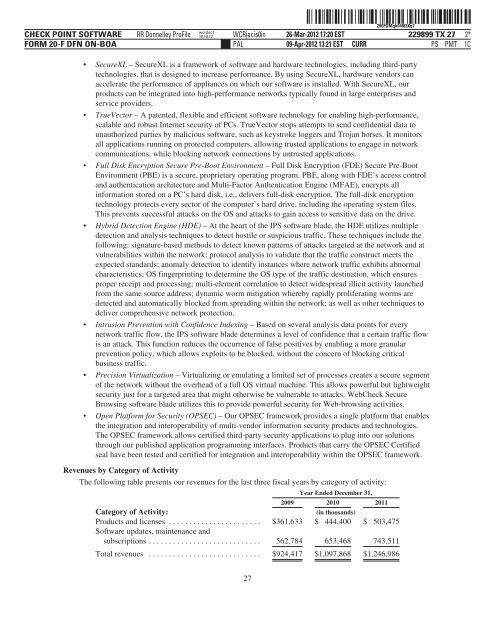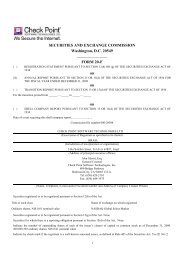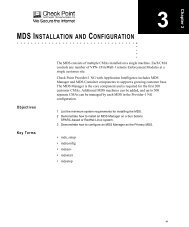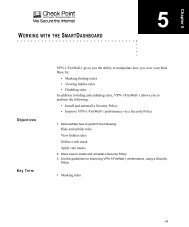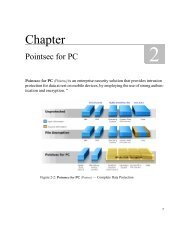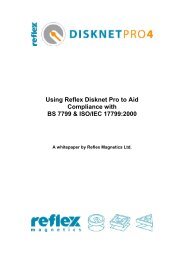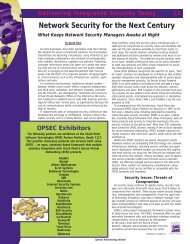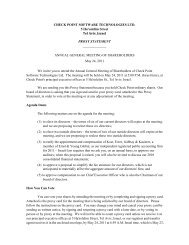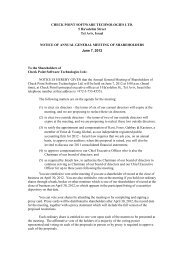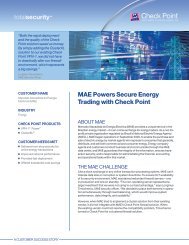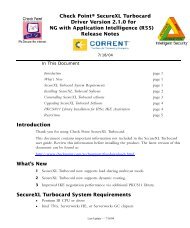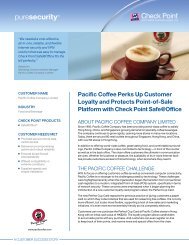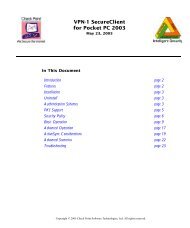printmgr file
printmgr file
printmgr file
You also want an ePaper? Increase the reach of your titles
YUMPU automatically turns print PDFs into web optimized ePapers that Google loves.
CHECK POINT SOFTWARE<br />
FORM 20-F DFN ON-BOA<br />
ˆ200FDMqk04f83Xq7-Š<br />
200FDMqk04f83Xq7<br />
RR Donnelley ProFile wcrdoc1<br />
10.10.12 WCRjacis0in 26-Mar-2012 17:20 EST<br />
229899 TX 27 2*<br />
PAL<br />
09-Apr-2012 13:21 EST CURR<br />
PS PMT 1C<br />
• SecureXL – SecureXL is a framework of software and hardware technologies, including third-party<br />
technologies, that is designed to increase performance. By using SecureXL, hardware vendors can<br />
accelerate the performance of appliances on which our software is installed. With SecureXL, our<br />
products can be integrated into high-performance networks typically found in large enterprises and<br />
service providers.<br />
• TrueVector – A patented, flexible and efficient software technology for enabling high-performance,<br />
scalable and robust Internet security of PCs. TrueVector stops attempts to send confidential data to<br />
unauthorized parties by malicious software, such as keystroke loggers and Trojan horses. It monitors<br />
all applications running on protected computers, allowing trusted applications to engage in network<br />
communications, while blocking network connections by untrusted applications.<br />
• Full Disk Encryption Secure Pre-Boot Environment – Full Disk Encryption (FDE) Secure Pre-Boot<br />
Environment (PBE) is a secure, proprietary operating program. PBE, along with FDE’s access control<br />
and authentication architecture and Multi-Factor Authentication Engine (MFAE), encrypts all<br />
information stored on a PC’s hard disk, i.e., delivers full-disk encryption. The full-disk encryption<br />
technology protects every sector of the computer’s hard drive, including the operating system <strong>file</strong>s.<br />
This prevents successful attacks on the OS and attacks to gain access to sensitive data on the drive.<br />
• Hybrid Detection Engine (HDE) – At the heart of the IPS software blade, the HDE utilizes multiple<br />
detection and analysis techniques to detect hostile or suspicious traffic. These techniques include the<br />
following: signature-based methods to detect known patterns of attacks targeted at the network and at<br />
vulnerabilities within the network; protocol analysis to validate that the traffic construct meets the<br />
expected standards; anomaly detection to identify instances where network traffic exhibits abnormal<br />
characteristics; OS fingerprinting to determine the OS type of the traffic destination, which ensures<br />
proper receipt and processing; multi-element correlation to detect widespread illicit activity launched<br />
from the same source address; dynamic worm mitigation whereby rapidly proliferating worms are<br />
detected and automatically blocked from spreading within the network; as well as other techniques to<br />
deliver comprehensive network protection.<br />
• Intrusion Prevention with Confidence Indexing – Based on several analysis data points for every<br />
network traffic flow, the IPS software blade determines a level of confidence that a certain traffic flow<br />
is an attack. This function reduces the occurrence of false positives by enabling a more granular<br />
prevention policy, which allows exploits to be blocked, without the concern of blocking critical<br />
business traffic.<br />
• Precision Virtualization – Virtualizing or emulating a limited set of processes creates a secure segment<br />
of the network without the overhead of a full OS virtual machine. This allows powerful but lightweight<br />
security just for a targeted area that might otherwise be vulnerable to attacks. WebCheck Secure<br />
Browsing software blade utilizes this to provide powerful security for Web-browsing activities.<br />
• Open Platform for Security (OPSEC) – Our OPSEC framework provides a single platform that enables<br />
the integration and interoperability of multi-vendor information security products and technologies.<br />
The OPSEC framework allows certified third-party security applications to plug into our solutions<br />
through our published application programming interfaces. Products that carry the OPSEC Certified<br />
seal have been tested and certified for integration and interoperability within the OPSEC framework.<br />
Revenues by Category of Activity<br />
The following table presents our revenues for the last three fiscal years by category of activity:<br />
Year Ended December 31,<br />
2009 2010 2011<br />
Category of Activity: (in thousands)<br />
Products and licenses .......................<br />
Software updates, maintenance and<br />
$361,633 $ 444,400 $ 503,475<br />
subscriptions ............................ 562,784 653,468 743,511<br />
Total revenues ............................ $924,417 $1,097,868 $1,246,986<br />
27


